 W
WAmpyx is an Ordovician-Silurian genus of Asaphid trilobites of the family Raphiophoridae. Species of Ampyx are characterized by three extended spines on the head-shield, one spine derived from each free cheek, and one spine emanating from the glabellum. Species include Ampyx linleyensis.
 W
WArchipelepis is a genus of extinct thelodont agnathans, and are the most primitive recognized thelodonts of which whole body fossils are known. Fossils of bodies and scales are currently known from Late Telychian to Wenlock-aged marine strata of northern Canada.
 W
WThe Armenoceratidae are a family of early Paleozoic nautiloid cephalopods belonging to the order Actinocerida.
 W
WAsaphida is a large, morphologically diverse order of trilobites found in marine strata dated from the Middle Cambrian until their extinction during the Silurian. Asaphida contains six superfamilies, but no suborders. Asaphids comprise some 20% of described fossil trilobites.
 W
WThe Ascocerida are comparatively small, bizarre Orthoceratoids known only from Ordovician and Silurian sediments in Europe and North America, uniquely characterized by a deciduous conch consisting of a longiconic juvenile portion and an inflated breviconic adult portion that separate sometime in maturity.
 W
WBirmanites is a genus of trilobites in the order Asaphida, family Asaphidae.
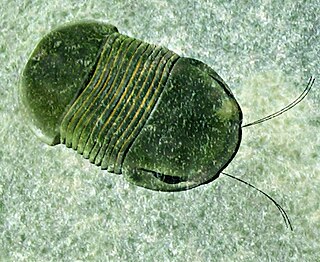 W
WBumastus is an extinct genus of corynexochid trilobites which existed from the Early Ordovician period to the Late Silurian period. They were relatively large trilobites, reaching a length of 6 in (15 cm). They were distinctive for their highly globular, smooth-surfaced exoskeleton. They possessed well-developed, large compound eyes and were believed to have dwelled in shallow-water sediments in life.
 W
WBunodidae is an extinct family of synziphosurine chelicerates that lived in the Silurian. Bunodidae is classified inside the clade Planaterga alongside Pseudoniscidae and Dekatriata. Bunodidae is composed by two genera, Bunodes and Limuloides.
 W
WChoiaella is an extinct genus of sea sponge ranging from the Chengjiang lagerstatten until the Lower Silurian.
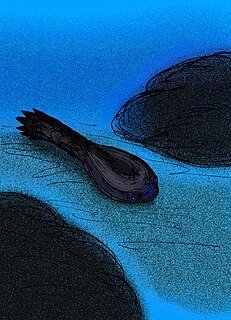 W
WCyathaspidida is a taxon of extinct cyathaspidiform heterostracan agnathans whose fossils are found in Silurian to Lower Devonian marine strata of Europe and North America. In life, they are thought to be benthic animals that lived most of their lives either mostly buried in or resting directly on top of the substrate.
 W
WCyathaspis is the type genus of the heterostracan order Cyathaspidiformes. Fossils are found in late Silurian strata in the Cunningham Creek Formation, New Brunswick, Canada and Europe, especially in the Downton Castle Sandstone of Great Britain and Gotland, Sweden. The living animal would have looked superficially like a tadpole, albeit covered in bony plates composed of the tissue aspidine, which is unique to heterostracan armor.
 W
WDiacalymene is a genus of trilobite from the order Phacopida, suborder Calymenina. It includes the species D. ouzregui, D. clavicula, D. diademata and D. gabrielsi. It lived in the Ordovician and Silurian periods.
 W
WThe Eocrinoidea are an extinct class of echinoderms that lived between the Early Cambrian and Late Silurian periods. They are the earliest known group of stalked, arm-bearing echinoderms, and were the most common echinoderms during the Cambrian.
 W
WFlexicalymene is a genus of trilobites of the order Phacopida, suborder Calymenina. They are found abundantly in North America. Flexicalymene specimens can be mistaken for Calymene, Gravicalymene, Diacalymene and a few other Calymenina genera. They are used as an index fossil in the Ordovician. Ohio and North America are particularly known for being rich with Flexicalymene fossils. Species include F. meeki and F. retrorsa, F. granulosa, F. senaria and F. croneisi (Ontario).
 W
WGlyptocrinus is an extinct genus of sea lily that lived from the Middle Ordovician to the Early Silurian. Its remains have been found in North America.
 W
WHalysites is an extinct genus of tabulate coral. Colonies range from less than one to tens of centimeters in diameter, and they fed upon plankton.
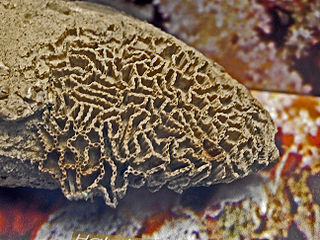 W
WHalysitidae is an extinct family of tabulate corals.
 W
WThe Kokomopteridae are a family of eurypterids, an extinct group of chelicerate arthropods commonly known as "sea scorpions". The family is one of two families contained in the superfamily Kokomopteroidea, which in turn is one of four superfamilies classified as part of the suborder Stylonurina.
 W
WLechritrochoceratidae is a family of derived tarphycerids from the middle and upper Silurian, once included in the now largely abandoned Barrandeocerida.
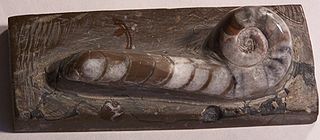 W
WThe Lituitidae are a family of evolved tarphycerids characterized by a long orthoconic section that follows a coiled juvenile portion at the apex, along with a generally tubular siphuncle, which like that of the barrandeocerids is composed of thin connecting rings.
 W
WMegistaspis is a genus of trilobites in the order Asaphida and family Asaphidae.
 W
WNaraoia is a genus of small to average size marine arthropods within the family Naraoiidae, that lived from the early Cambrian to the late Silurian period. The species are characterized by a large alimentary system and sideways oriented antennas.
 W
WNaraoiidae is a family, of extinct, soft-shelled trilobite-like arthropods, that belongs to the order Nectaspida. Species included in the Naraoiidae are known from the second half of the Lower Cambrian to the end of the Upper Silurian. The total number of collection sites is limited and distributed over a vast period of time: Maotianshan Shale and Balang Formation (China), Burgess Shale and Bertie Formation (Canada), the Šárka Formation, Emu Bay Shale (Australia), Idaho and Utah (USA). This is probably due to the rare occurrence of the right circumstances for soft tissue preservation, needed for these non-calcified exoskeletons.
 W
WNektaspida is an extinct order of soft-bodied arthropods proposed by Raymond in 1920; its taxonomic status is uncertain. Specimens are known from the early Cambrian to the upper Silurian periods. A Russian find in de Vendian of the White Sea (=Ediacaran) has in 2006 also been attributed to this order, which would make it the earliest antropod found yet. Whittington (1985) placed the order in the Trilobita. Cotton & Braddy (2000) place it in a new "Trilobite clade" containing the Trilobita, recognizing the close affinities of the nektaspids to trilobites. However this necessitates the inclusion of genera that look very little like trilobites., it was formerly placed in the stem-group to the chelicerata subdivision of the Arthropoda phylum. However, it currently considered part of Artiopoda.
 W
WOncoceratidae is a family of nauatiloid cephalopods in the order Oncocerida established by Hyatt, 1884, that range from the Middle Ordovician to the Upper Silurian.
 W
WThe palaeoscolecids are a group of extinct ecdysozoan worms resembling armoured priapulids. They are known from the Lower Cambrian to the late Silurian; they are mainly found as disarticulated sclerites, but are also preserved in many of the Cambrian lagerstätten. They take their name from the typifying genus Palaeoscolex.
 W
WParacrinoidea is an extinct class of blastozoan echinoderms. They lived in shallow seas during the Early Ordovician through the Early Silurian. While blastozoans are usually characterized by types of respiratory structures present, it is not clear what types of respiratory structures paracrinoids likely had. Despite the taxon's name, the paracrinoids are not closely related to crinoids.
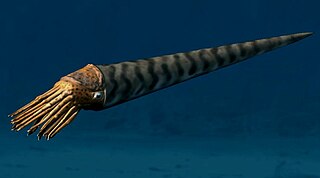 W
WParaphragmitidae is an extinct family of actively mobile aquatic carnivorous cephalopods belonging to the subclass Orthoceratoidea endemic to what would be Asia and Europe during the Silurian living from 436—418.7 mya, existing for approximately 17.3 million years .
 W
WThe Parastylonuridae are a family of eurypterids, an extinct group of chelicerate arthropods commonly known as "sea scorpions". The family is one of two families contained in the superfamily Stylonuroidea, which in turn is one of four superfamilies classified as part of the suborder Stylonurina.
 W
WPhlebolepididae is an extinct thelodont agnathan family in the order Thelodontiformes.
 W
WThe Phragmoceratidae is a family of extinct nautiloid cephalopods from the Order Discosorida that lived during the latter part of the Silurian.
 W
WPlaesiomyidae is a family of extinct lamp shells belonging to the order Orthida.
 W
WPlatystrophia is an extinct genus of brachiopods that lived from the Ordovician to the Silurian in Asia, Europe, North America, and South America. It has a prominent sulcus and fold. It usually lived in marine lime mud and sands.
 W
WProetus is a genus of proetid trilobite found in Silurian-aged marine strata of Europe.
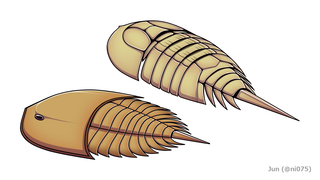 W
WPseudoniscidae is an extinct family of synziphosurine chelicerates that lived in the Silurian. Pseudoniscidae is classified inside the clade Planaterga, alongside Bunodidae and Dekatriata. Pseudoniscidae is composed by two genera, Cyamocephalus and Pseudoniscus.
 W
WPseudorthoceratidae is an extinct family of actively mobile aquatic carnivorous cephalopods belonging to the subclass Orthoceratoidea endemic to what would be North America, Asia, and Europe during the Silurian living from 460.5—251 Ma, existing for approximately 209.5 million years .
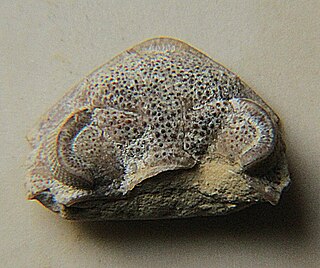 W
WThe Pterygometopidae are a family of trilobites, that is known from the Floian to the Katian (Ordovician), and reappears from the Telychian to the Sheinwoodian (Silurian). As part of the Phacopina suborder, its members have schizochroal eyes.
 W
WRaphiophoridae is a family of small to average-sized trilobites that first occurred at the start of the Ordovician and became extinct at the end of the Middle Silurian.
 W
WSlender Oncoceratidae are those in the family Oncoceratidae, which have slender, commonly curved, shells. Some like Oocerina are gently curved, almost straight, and with only slight expansion. Others like Dunleithoceras are strongly curved with a more notable rate of expansion. Inclusion in this somewhat arbitrary category is based on illustrations in the Treatise Part K, 1964.
 W
WSlimonia is a genus of eurypterid, an extinct group of aquatic arthropods. Fossils of Slimonia have been discovered in deposits of Silurian age in South America and Europe. Classified as part of the family Slimonidae alongside the related Salteropterus, the genus contains three valid species, S. acuminata from Lesmahagow, Scotland, S. boliviana from Cochabamba, Bolivia and S. dubia from the Pentland Hills of Scotland and one dubious species, S. stylops, from Herefordshire, England. The generic name is derived from and honors Robert Slimon, a fossil collector and surgeon from Lesmahagow.
 W
WSphaerexochus is a genus of trilobite from the Middle Ordovician to Late Silurian of Asia, Australia, Europe, and North America.
 W
WStenaster is an extinct genus of brittle stars that lived from the Ordovician to the Silurian.
 W
WStrophomena is a genus of brachiopods belonging to the order Strophomenida family Strophomenidae, named by Rafinesque in 1824. They were stationary epifaunal suspension feeders.
 W
WStyginidae is a family of trilobite in the order Corynexochida. Fossils of the various genera are found in marine strata throughout the world, aged from Ordovician up until the family's extinction during the Silurian.
 W
WThelodontiformes is an extinct order of jawless fish of the Silurian.
 W
WTrimeroceratidae is a family of molluscs in the order Oncocerida. These molluscs were fast-moving nektobenthic carnivores. They lived in the Silurian period.
 W
WTryblidium is a paleozoic genus of Ordovician and Silurian monoplacophorans.
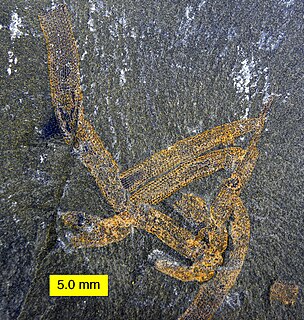 W
WVauxia is an extinct genus of demosponge that had a distinctive branching mode of growth. Each branch consisted of a network of strands. Vauxia also had a skeleton of spongin common to modern day sponges. Much like Choia and other sponges, Vauxia fed by extracting nutrients from the water.